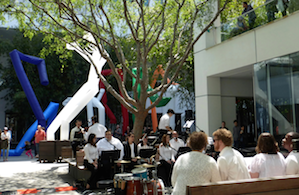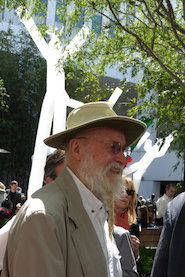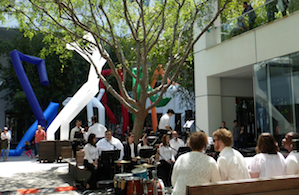
The “Minimalist Jukebox” is spinning Los Angeles itself. This grand exploration of minimalism (which continues through May 4) has already presented such diverse musical experiences as John Adams’ opera The Death of Klinghoffer, the electro/techno pulsations of Kraftwerk, and compositions by Philip Glass and Steve Reich, as well as an abundance of works by their compositional or generational offspring.
April 11 and 12, however, belonged to the man who started it all: Terry Riley. In the course of 24 hours the Los Angeles Philharmonic premiered his decidedly maximal organ concerto, At the Royal Majestic, at Walt Disney Concert Hall, followed the next day by a four-hour celebratory performance of In C outdoors at the Hammer Museum in Westwood, conceived by L.A.’s talk-of-the-town producer Yuval Sharon and his organization, the Industry.
Born June 25, 1935, in Colfax, California, Terry Riley evolved as a composer and musician over a lifetime of various influences. He grew up listening to the music of the movies and the free-flowing riffs of John Coltrane and Miles Davis. He discovered North Indian raga singing and studied with its iconic interpreter, Pandit Pran Nath. He also pioneered the new craft of electronic music, creating such mind-bending compositions as A Rainbow in Curved Air (recorded in 1968). And while there won’t be a performance of The Who’s 1971 rock classic Baba O’Riley as part of the Minimalist Jukebox, there certainly should be.
In 1964, In C, with its unique formula consisting of 53 separate modules of roughly one measure apiece (each containing a different musical pattern), lay siege to the fortress of approved academic modernism. It sent shockwaves into the musical stratosphere that are still reverberating.
If In C is Riley’s minimalist jewel, At the Royal Majestic is his Hollywood epic ... it turns Disney Hall’s Frank Gehry–designed organ (which Riley dubbed “Hurricane Mama”) into the latest incarnation of a mighty Wurlitzer.
Now, 50 years later, we have At the Royal Majestic, a work that has as much in common with George Gershwin’s Rhapsody in Blue as it does with In C. If In C is Riley’s minimalist jewel, At the Royal Majestic is his Hollywood epic. Composed for an enormous orchestra including no fewer than four flutes, four clarinets, four alto saxophones, two electric guitars, and two electric basses, it turns Disney Hall’s Frank Gehry–designed organ (which Riley dubbed “Hurricane Mama”) into the latest incarnation of a mighty Wurlitzer. And in true L.A. showbiz style, a rock star organist, Cameron Carpenter, was chosen to perform the premiere.
The inspiration for the first movement (which takes up more than half of the 37-minute composition) incorporates material that Riley created but never used in his 1990 chamber opera, The Saint Adolf Ring.

The first movement of At the Grand Majestic is based on a colored pencil drawing, called “Negro Hall,” by the great outsider artist Adolf Wölfli, Riley writes in his program notes. I was intrigued by what Wölfli, who never left Switzerland and lived the last half of his life in a mental institution, thought about negro culture. I tried to imagine what a dance hall in New York City’s Waldorf Astoria Hotel in the 1930s might have been like (from Wölfli’s perspective), with a gaggle of black dancers performing outlandish jitterbug and boogie-woogie routines in a polymetric, changing-tempo frenzy.
After the initial entrance of the organ, which Riley says is meant to evoke memories of those mighty Wurlitzers, the orchestra and the organ (conducted by John Adams) proceed down a variety of melodic alleyways, some in syncopated harmony, others more combative and adversarial. The mood varies between shadowy, sophisticated rhythms and instrumental collisions of epic proportion.
Some of the notes I scribbled down included “whirling winds,” “car-horn brass,” “Hollywood romantic strings,” “antiphonal percussion” … and “NOTHING ABOUT THIS IS MINIMAL!”
The extroverted atmosphere of the “Negro Hall” movement turns decidedly more languid in the much shorter second movement, “The Lizard Tower Gang” — a title, Riley explained, inspired by a cadre of lizards that inhabit his ranch in the Sierra foothills. Here Riley’s minimalist roots are more evident, as pulsations from the organ are contrasted with solo passages for alto saxophone, trumpets, and bassoon.
A distinct sense of Hollywood flavoring returns in the third movement, “Circling Kailish.” But this time the music takes on more of a Bernard Herrmann edge. Propelled by Carpenter (in tight black leather pants and sequined top), the organ and the orchestra surf on a series of rising and falling swells comprising repeating melodic patterns both in unison and in canon. And at one point the organ even transforms itself into a slightly scary circus calliope.
At the Grand Majestic is a knock-your-socks-off composition that melds many voices, memories, and ideas into a concerto structure. It certainly does not play it safe. But that’s Terry Riley.
The effect was startling — like a deconstruction and then a reassembly, as all the players and singers, including Sharon on toy piano, joined in for the final hour’s culmination. It was joyous. It was hypnotic. It was altogether In C.
According to the Industry’s Yuval Sharon, the inspiration for Riley’s 50th anniversary celebration of In C happened in the car — how appropriate for L.A. The composer saw one of those dancing inflatable figures in front of a car wash and imagined an entire troop of these rising and falling fellows dancing to his celebrated 1965 work. And that’s exactly what he ordered up.
As the crowd gathered in the atrium of the Hammer Museum in Westwood, and the first pulse note of In C sounded on the marimba, three air-filled white figures, plus three geometric forms in bold primary colors, rose and began to perform a dance of joy reminiscent of the paintings of Matisse.
This went on for four uninterrupted hours as people came and went, sat in the sun, sipped wine, had lunch. Kids frolicked with the inflated figures as the musical pattern evolved, highlighted by members of the INSPIRAVI Vocal Ensemble and members of the Ate9 dANCEcOMPANY, who turned the entire museum into a stage.
The performance was also, in its own way, a premiere, since hours two and three were performed as solos, first by clarinetist Brian Walsh and then by drummer Corey Fogel, each accompanied by a prerecorded pulse of mallet instruments and piano. The effect was startling — like a deconstruction and then a reassembly, as all the players and singers, including Sharon on toy piano, joined in for the final hour’s culmination. It was joyous. It was hypnotic. It was altogether In C.

